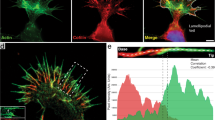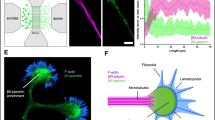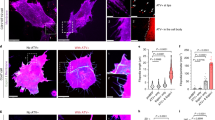Abstract
THE neuronal growth cone is thought to be the site of decision making in nerve growth and guidance1,2. One likely mechanism of how the growth cone translates various extracellular cues into directed motility involves rises in intracellular calcium. A variety of physiological cues, such as adhesion molecules and neuro-transmitters, increases intracellular calcium1, and artificial manipulations of growth cone calcium levels affect growth cone morphology and neurite outgrowth3. The molecular events downstream of calcium fluxes are incompletely understood. Here we show that calcineurin, a protein phosphatase enriched in growth cones that is dependent on calcium ions and calmodulin4, functions in neurite outgrowth and directed filopodial motility in cultured chick dorsal root ganglia neurons. Cyclosporin A and FK506, inhibitors of calcineurin5, delayed neuritogenesis and inhibited neurite extension. Chromophore-assisted laser inactivation of calcineurin in regions of growth cones causes localized filopodial and lamellipodial retraction and influences the direction of subsequent outgrowth. We suggest that a spatial distribution of calcineurin activity within the growth cone can regulate motility and direct outgrowth.
This is a preview of subscription content, access via your institution
Access options
Subscribe to this journal
Receive 51 print issues and online access
$199.00 per year
only $3.90 per issue
Buy this article
- Purchase on Springer Link
- Instant access to full article PDF
Prices may be subject to local taxes which are calculated during checkout
Similar content being viewed by others
References
Strittmatter, S. M. & Fishman, M. C. BioEssays 13, 127–134 (1991).
Goodman, C. S. & Shatz, C. J. Cell 72/Neuron 10 (suppl.), 77–98 (1993).
Rehder, V. & Kater, S. B. J. Neurosci. 12, 3175–3186 (1992).
Ferreira, A., Kincaid, R. L. & Kosik, K. S. Molec. Biol. Cell 4, 1225–1238 (1993).
Liu, J. et al. Cell 66, 807–815 (1991).
Steiner, J. P. et al. Nature 358, 584–587 (1992).
Liu, J. et al. Biochemistry 31, 3896–3901 (1992).
Snyder, S. H. & Sabatini, D. M. Nature Med. 1, 32–37 (1995).
Clipstone, N. A. & Crabtree, G. R. Nature 357, 695–697 (1993).
Jay, D. G. & Keshishian, H. Nature 348, 548–550 (1990).
Diamond, P. et al. Neuron 11, 409–421 (1993).
Liao, J. C., Raider, J. & Jay, D. G. Proc. natn. Acad. Sci. U.S.A. 91, 2659–2663 (1994).
Linden, K. G., Liao, J. C. & Jay, D. G. Biophys. J. 61, 956–962 (1992).
Schmucker, D., Su, A. L., Beermann, A., Jackle, H. & Jay, D. G. Proc. natn. Acad. Sci. U.S.A. 91, 2664–2668 (1994).
Sydor, A. M. & Jay, D. G. Abs. Soc. Neurosci. 20, 1474 (1994).
Van Hooff, C. O. M., De Graan, P. N. E., Oestreicher, A. B. & Gisper, W. A. J. Neurosci. 8, 1789–1795 (1988).
Selden, S. C. & Pollard, T. P. J. biol. Chem. 258, 7064–7071 (1983).
Liu, J.-P. et al. Science 265, 970–973 (1994).
Janmey, P. A. & Stossel, T. P. Nature 325, 362–364 (1987).
Davenport, R. W., Dou, P., Rehder, V. & Kater, S. B. Nature 361, 721–724 (1993).
Mitchison, T. & Kirschner, M. Neuron 1, 761–772 (1988).
Zheng, J. Q., Felder, M., Connor, J. A. & Poo, M.-m. Nature 368, 140–143 (1994).
Hendey, B., Klee, C. B. & Maxfield, C. R. Science 258, 296–299 (1992).
Bram, R. J., Hung, D. T., Martin, P. K., Schreiber, S. L. & Crabtree, G. R. Molec. cell. Biol. 13, 4760–4769 (1993).
Bray, D. Culturing Nerve Cells (eds Banker, G. & Goslin, K.) 104–120 (MIT Press, Cambridge, MA, 1991).
Klee, C. B. et al. Meth. Enzym. 102, 227–256 (1983).
Sambrook, J., Fritsch, E. F. & Maniatis, T. Molecular Cloning: A Laboratory Manual (Cold Spring Harbor Laboratory Press, New York, 1989).
Haddy, A., Swanson, S. K., Born, T. L. & Rusnak, F. FEBS Lett. 314, 37–40 (1992).
Letourneau, P. C. & Shattuck, T. A. Development 105, 505–519 (1989).
Clarke, M. S. F. & McNeil, P. L. J. Cell Sci. 102, 533–541 (1992).
Author information
Authors and Affiliations
Rights and permissions
About this article
Cite this article
Chang, H., Takei, K., Sydor, A. et al. Asymmetric retraction of growth cone filopodia following focal inactivation of calcineurin. Nature 376, 686–690 (1995). https://doi.org/10.1038/376686a0
Received:
Accepted:
Issue Date:
DOI: https://doi.org/10.1038/376686a0
This article is cited by
-
Rasal1 regulates calcium dependent neuronal maturation by modifying microtubule dynamics
Cell & Bioscience (2024)
-
Chromophore-assisted laser inactivation in neural development
Neuroscience Bulletin (2012)
-
Dissecting the link between stress fibres and focal adhesions by CALI with EGFP fusion proteins
Nature Cell Biology (2002)
-
Treatment of hippocampal neurons with cyclosporin A results in calcium overload and apoptosis which are independent on NMDA receptor activation
British Journal of Pharmacology (2001)
-
Role of the NF-ATc transcription factor in morphogenesis of cardiac valves and septum
Nature (1998)
Comments
By submitting a comment you agree to abide by our Terms and Community Guidelines. If you find something abusive or that does not comply with our terms or guidelines please flag it as inappropriate.



